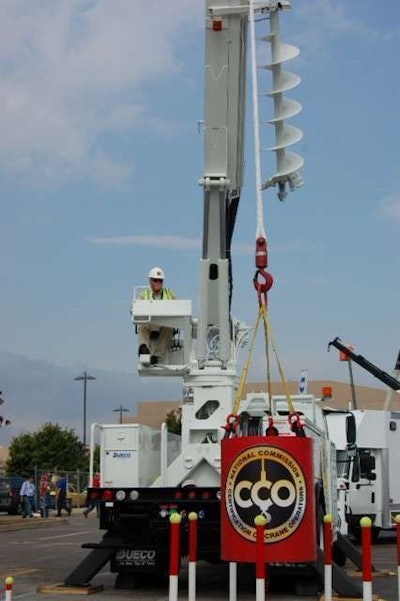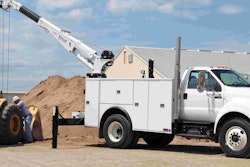 Thomas De Soo, director I&I Sling/Slingmax Rigging Solutions, demonstrates a typical test situation used in qualifying and certifying rigging personnel.
Thomas De Soo, director I&I Sling/Slingmax Rigging Solutions, demonstrates a typical test situation used in qualifying and certifying rigging personnel.ICUEE is known as a hands-on demo show and that’s exactly what the National Commission for the Certification of Crane Operators provided in Louisville last week.
The NCCCO brought its Lift Safety Zone to ICUEE last week with a number of live demonstrations of the practical testing operators are required to perform to get certified.
These include certifications for digger derrick operators, articulating crane operators and the new service truck operator certifications. Also demonstrated were the rigger level I and level II practical exams.
In addition to the demonstrations, NCCCO offered both written and practical exams
 Are you this good? Roy Bolton, crane operator training coordinator at Cianbro, moves a load through an obstacle field, demonstrating one of the hands-on tests required for certification.
Are you this good? Roy Bolton, crane operator training coordinator at Cianbro, moves a load through an obstacle field, demonstrating one of the hands-on tests required for certification.using the association’s onsite scoring system. This enabled test takers to come to ICUEE and leave certified.
The NCCCO’s Lift Safety Zone will make a return appearance at ConExpo, March 4-8, 2014 in Las Vegas and will likewise include demonstrations and on-site testing. For more information go to www.nccco.org.
Crane operator certification has become a hot topic of late with new OSHA rules, in particular the new rules for certifying service truck crane operators. Although OSHA delayed implementation of the service truck crane operator certification requirement, there are requirements for operators, riggers and signal people to be qualified, as well as new rules for documentation and operation around power lines.
These rules went into effect in November 2010. OSHA has fined contractors for not following these new regulations. Yet the new regulations are not well known, in part because they represent the first attempt OSHA has made to regulate service truck cranes. Qualification is not as rigorous a process as certification, but it is required now to operate most cranes used in new construction above 2,000 pounds in lifting capacity.









